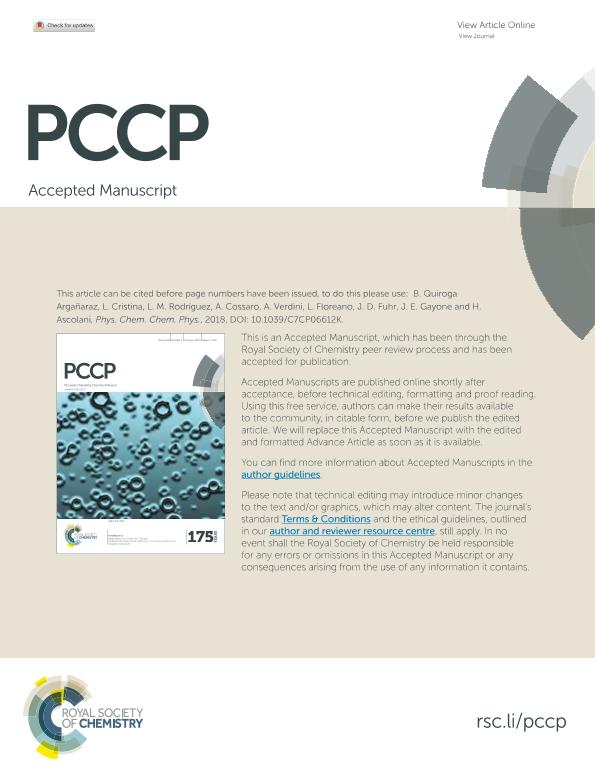Mostrar el registro sencillo del ítem
dc.contributor.author
Quiroga Argañaraz, Maria Bernarda

dc.contributor.author
Cristina, Lucila Josefina

dc.contributor.author
Parra Rodríguez, Laura María

dc.contributor.author
Cossaro, A.
dc.contributor.author
Verdini, A.
dc.contributor.author
Floreano, L.
dc.contributor.author
Fuhr, Javier Daniel

dc.contributor.author
Gayone, Julio Esteban

dc.contributor.author
Ascolani, Hugo del Lujan

dc.date.available
2019-10-22T19:51:11Z
dc.date.issued
2018-06-09
dc.identifier.citation
Quiroga Argañaraz, Maria Bernarda; Cristina, Lucila Josefina; Parra Rodríguez, Laura María; Cossaro, A.; Verdini, A.; et al.; Ubiquitous deprotonation of terephthalic acid in the self-assembled phases on Cu(100); Royal Society of Chemistry; Physical Chemistry Chemical Physics; 20; 6; 9-6-2018; 4329-4339
dc.identifier.issn
1463-9076
dc.identifier.uri
http://hdl.handle.net/11336/86984
dc.description.abstract
We performed an exhaustive study of terephthalic acid (TPA) self-assembly on a Cu(100) surface, where first-layer molecules display two sequential phase transitions in the 200-400 K temperature range, corresponding to different stages of molecular deprotonation. We followed the chemical and structural changes by means of high-resolution X-ray photoelectron spectroscopy (XPS) and variable-temperature scanning tunneling microscopy (STM), which were interpreted on the basis of density functional theory (DFT) calculations and photoemission simulations. In order to reveal the spectroscopic contributions of the molecules in different states of deprotonation, we modified the substrate reactivity by deposition of a small amount of Sn, which hampers the deprotonation reaction. We found that the characteristic molecular ribbons of the TPA/Cu(100) α-phase at a low temperature contain a significant fraction of partially deprotonated molecules, in contrast to the expectation of a fully protonated phase, where the self-assembly was claimed to be simply driven by the intermolecular double hydrogen bonds [OH⋯O]. On the basis of our simulations, we propose a model where the carboxylate groups of the partially deprotonated molecules form single hydrogen bonds with the carboxylic groups of the fully protonated molecules. Using real time XPS, we also monitored the kinetics of the deprotonation reaction. We show that the network of mixed single and double hydrogen bonds inhibits further deprotonation up to ∼270 K, whereas the isolated molecules display a much lower deprotonation barrier.
dc.format
application/pdf
dc.language.iso
eng
dc.publisher
Royal Society of Chemistry

dc.rights
info:eu-repo/semantics/openAccess
dc.rights.uri
https://creativecommons.org/licenses/by-nc-sa/2.5/ar/
dc.subject
TEREPHTHALIC ACID
dc.subject
SELF-ASSEMBLY
dc.subject
CU(100)
dc.subject
SURFACES
dc.subject
TEREPHTHALIC ACID
dc.subject.classification
Física Atómica, Molecular y Química

dc.subject.classification
Ciencias Físicas

dc.subject.classification
CIENCIAS NATURALES Y EXACTAS

dc.title
Ubiquitous deprotonation of terephthalic acid in the self-assembled phases on Cu(100)
dc.type
info:eu-repo/semantics/article
dc.type
info:ar-repo/semantics/artículo
dc.type
info:eu-repo/semantics/publishedVersion
dc.date.updated
2019-10-10T14:59:09Z
dc.journal.volume
20
dc.journal.number
6
dc.journal.pagination
4329-4339
dc.journal.pais
Reino Unido

dc.journal.ciudad
Cambridge
dc.description.fil
Fil: Quiroga Argañaraz, Maria Bernarda. Consejo Nacional de Investigaciones Científicas y Técnicas. Centro Científico Tecnológico Conicet - Patagonia Norte; Argentina. Comisión Nacional de Energía Atómica. Centro Atómico Bariloche; Argentina
dc.description.fil
Fil: Cristina, Lucila Josefina. Consejo Nacional de Investigaciones Científicas y Técnicas. Centro Científico Tecnológico Conicet - Patagonia Norte; Argentina. Comisión Nacional de Energía Atómica. Centro Atómico Bariloche; Argentina. Consejo Nacional de Investigaciones Científicas y Técnicas. Centro Científico Tecnológico Conicet - Bahía Blanca. Instituto de Física del Sur. Universidad Nacional del Sur. Departamento de Física. Instituto de Física del Sur; Argentina
dc.description.fil
Fil: Parra Rodríguez, Laura María. Comisión Nacional de Energía Atómica. Centro Atómico Bariloche; Argentina
dc.description.fil
Fil: Cossaro, A.. Consiglio Nazionale delle Ricerche; Italia
dc.description.fil
Fil: Verdini, A.. Consiglio Nazionale delle Ricerche; Italia
dc.description.fil
Fil: Floreano, L.. Consiglio Nazionale delle Ricerche; Italia
dc.description.fil
Fil: Fuhr, Javier Daniel. Consejo Nacional de Investigaciones Científicas y Técnicas. Centro Científico Tecnológico Conicet - Patagonia Norte; Argentina. Comisión Nacional de Energía Atómica. Centro Atómico Bariloche; Argentina
dc.description.fil
Fil: Gayone, Julio Esteban. Consejo Nacional de Investigaciones Científicas y Técnicas. Centro Científico Tecnológico Conicet - Patagonia Norte; Argentina. Comisión Nacional de Energía Atómica. Centro Atómico Bariloche; Argentina
dc.description.fil
Fil: Ascolani, Hugo del Lujan. Consejo Nacional de Investigaciones Científicas y Técnicas. Centro Científico Tecnológico Conicet - Patagonia Norte; Argentina. Comisión Nacional de Energía Atómica. Centro Atómico Bariloche; Argentina
dc.journal.title
Physical Chemistry Chemical Physics

dc.relation.alternativeid
info:eu-repo/semantics/altIdentifier/url/https://pubs.rsc.org/en/content/articlelanding/2018/CP/C7CP06612K#!divAbstract
dc.relation.alternativeid
info:eu-repo/semantics/altIdentifier/doi/http://dx.doi.org/10.1039/C7CP06612K
Archivos asociados
